Case Study: International Crisis Management of the Rohingya in Myanmar
VerifiedAdded on 2023/06/12
|7
|1189
|449
Case Study
AI Summary
This case study provides an overview of the Rohingya crisis in Myanmar, examining the historical context, the reasons behind the change of name from Burma to Myanmar, and the details of the Rohingya crisis including the mass migration in 2017. It highlights the warming signals leading to the crisis, the nations affected, and the reactions of the international community, including the roles of China, India, the United Nations, and the United States. Furthermore, it discusses China's three-point plan for resolving the crisis and outlines potential steps for international crisis management, such as opening safe routes for refugees, ensuring resettlement, and prosecuting trafficking gangs. The study references various sources to support its analysis of the complex humanitarian and political issues involved.
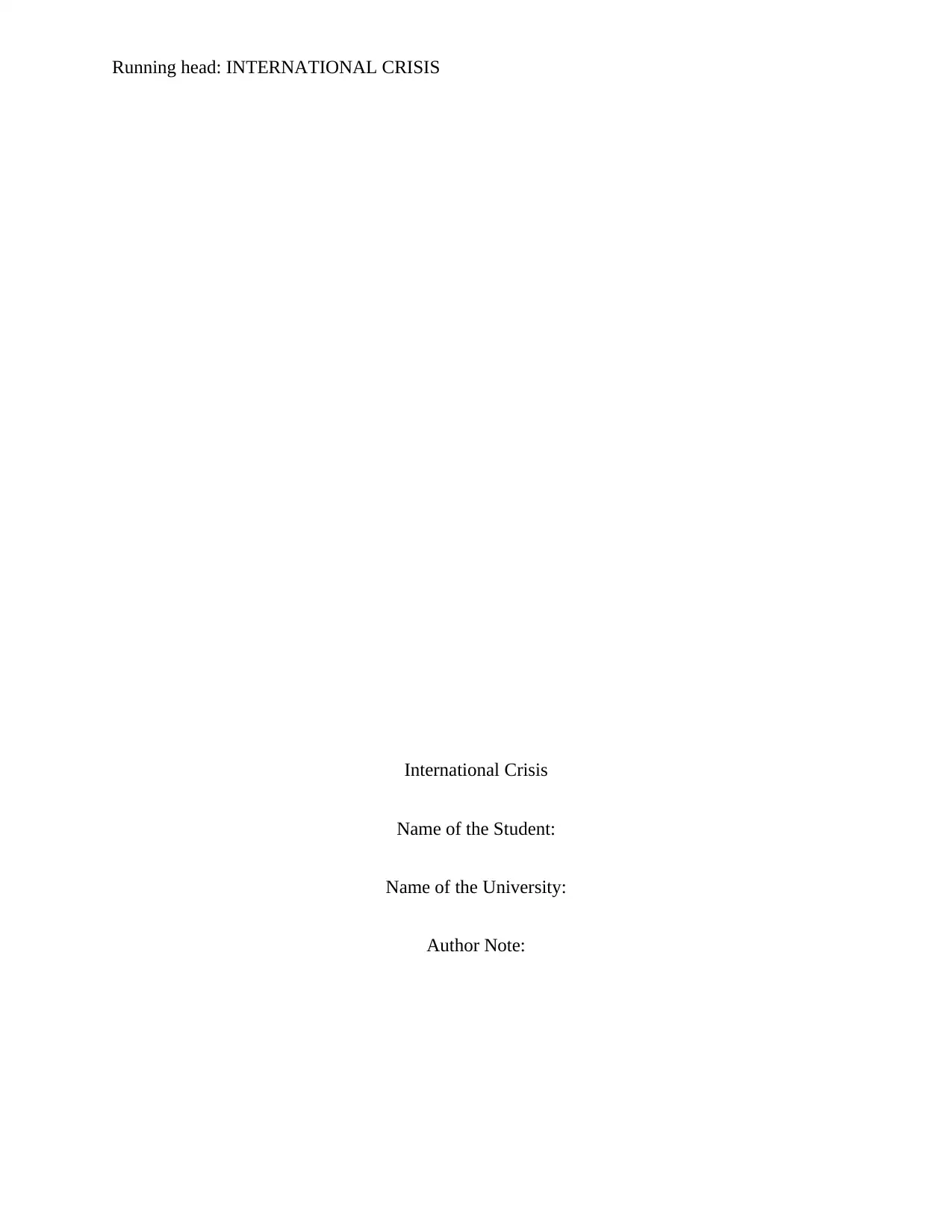
Running head: INTERNATIONAL CRISIS
International Crisis
Name of the Student:
Name of the University:
Author Note:
International Crisis
Name of the Student:
Name of the University:
Author Note:
Paraphrase This Document
Need a fresh take? Get an instant paraphrase of this document with our AI Paraphraser
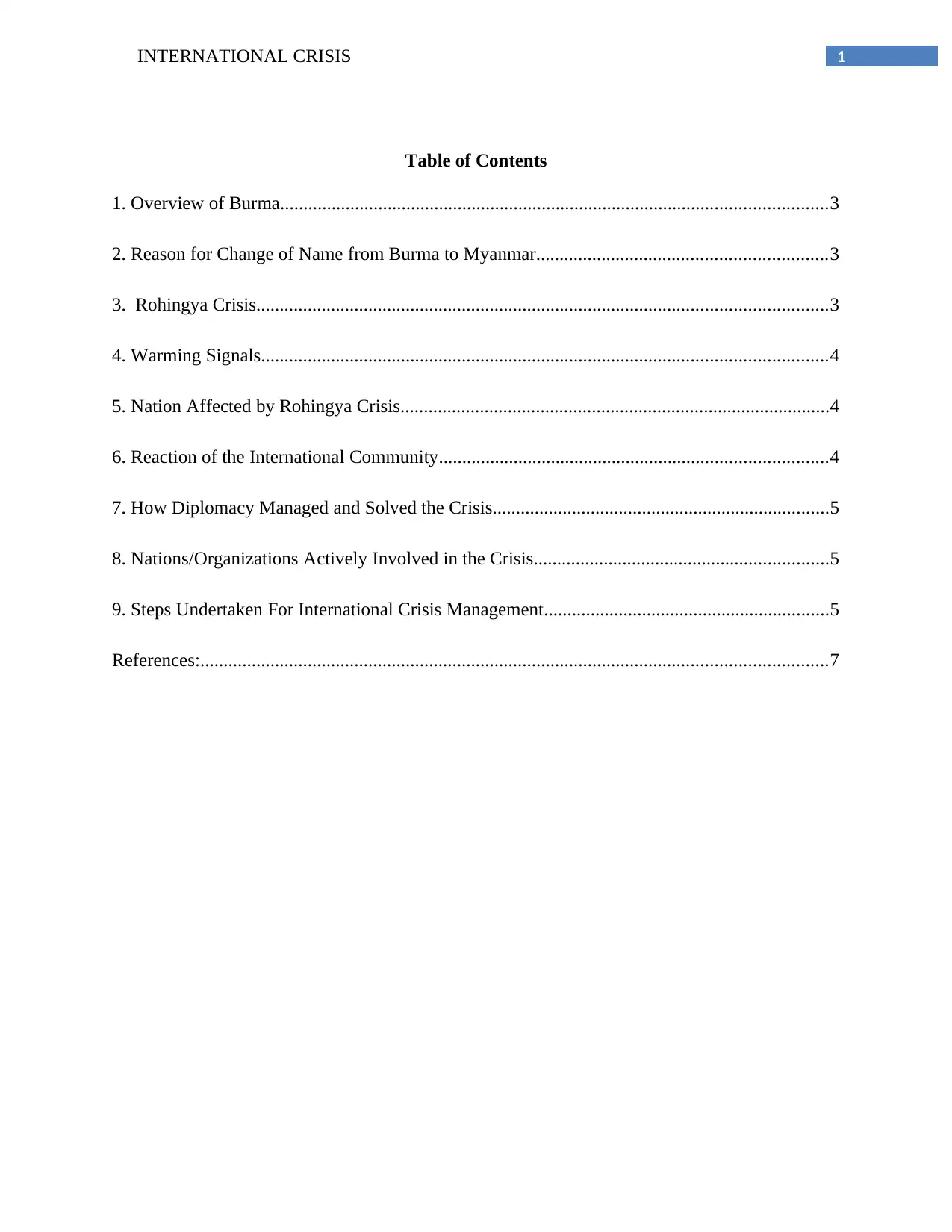
1INTERNATIONAL CRISIS
Table of Contents
1. Overview of Burma.....................................................................................................................3
2. Reason for Change of Name from Burma to Myanmar..............................................................3
3. Rohingya Crisis..........................................................................................................................3
4. Warming Signals.........................................................................................................................4
5. Nation Affected by Rohingya Crisis............................................................................................4
6. Reaction of the International Community...................................................................................4
7. How Diplomacy Managed and Solved the Crisis........................................................................5
8. Nations/Organizations Actively Involved in the Crisis...............................................................5
9. Steps Undertaken For International Crisis Management.............................................................5
References:......................................................................................................................................7
Table of Contents
1. Overview of Burma.....................................................................................................................3
2. Reason for Change of Name from Burma to Myanmar..............................................................3
3. Rohingya Crisis..........................................................................................................................3
4. Warming Signals.........................................................................................................................4
5. Nation Affected by Rohingya Crisis............................................................................................4
6. Reaction of the International Community...................................................................................4
7. How Diplomacy Managed and Solved the Crisis........................................................................5
8. Nations/Organizations Actively Involved in the Crisis...............................................................5
9. Steps Undertaken For International Crisis Management.............................................................5
References:......................................................................................................................................7
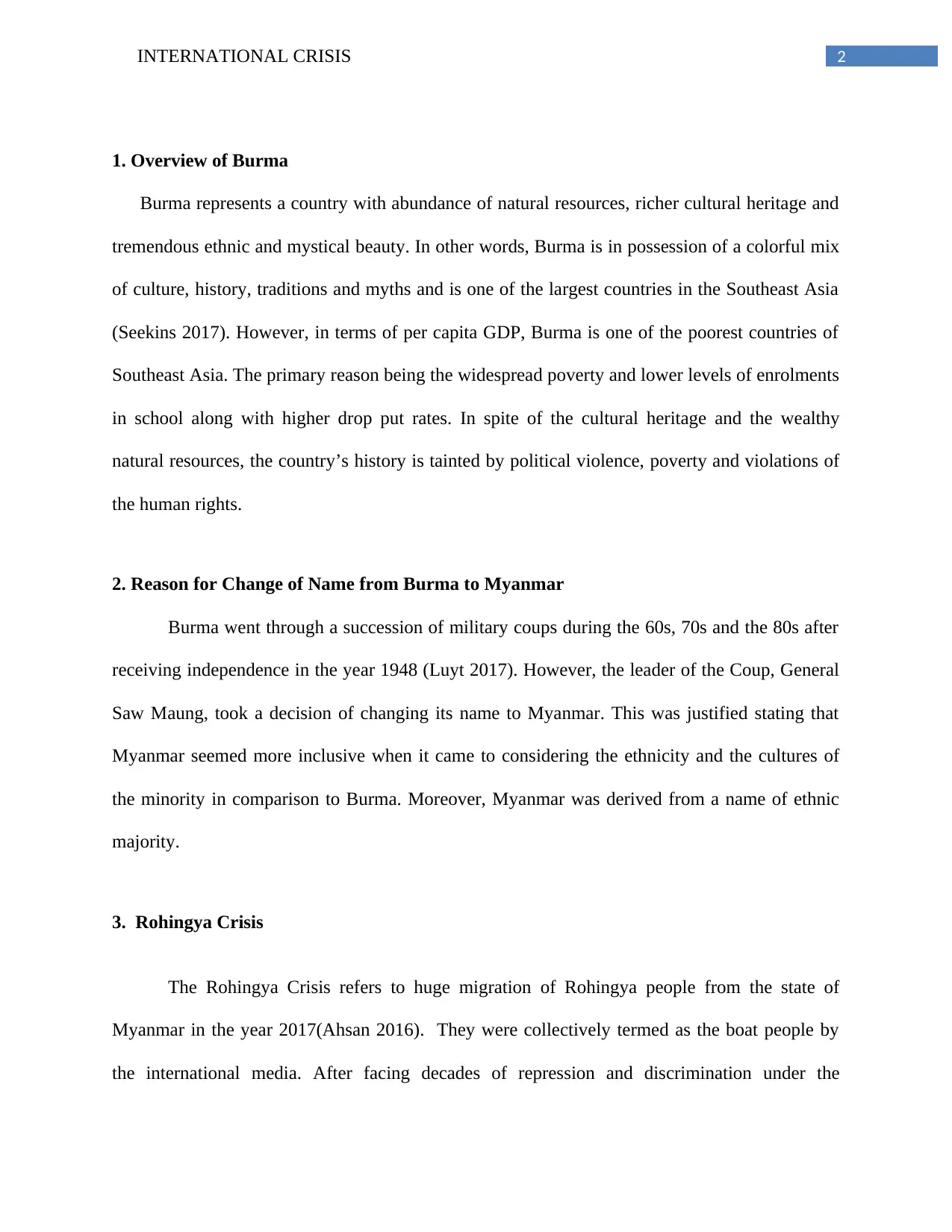
2INTERNATIONAL CRISIS
1. Overview of Burma
Burma represents a country with abundance of natural resources, richer cultural heritage and
tremendous ethnic and mystical beauty. In other words, Burma is in possession of a colorful mix
of culture, history, traditions and myths and is one of the largest countries in the Southeast Asia
(Seekins 2017). However, in terms of per capita GDP, Burma is one of the poorest countries of
Southeast Asia. The primary reason being the widespread poverty and lower levels of enrolments
in school along with higher drop put rates. In spite of the cultural heritage and the wealthy
natural resources, the country’s history is tainted by political violence, poverty and violations of
the human rights.
2. Reason for Change of Name from Burma to Myanmar
Burma went through a succession of military coups during the 60s, 70s and the 80s after
receiving independence in the year 1948 (Luyt 2017). However, the leader of the Coup, General
Saw Maung, took a decision of changing its name to Myanmar. This was justified stating that
Myanmar seemed more inclusive when it came to considering the ethnicity and the cultures of
the minority in comparison to Burma. Moreover, Myanmar was derived from a name of ethnic
majority.
3. Rohingya Crisis
The Rohingya Crisis refers to huge migration of Rohingya people from the state of
Myanmar in the year 2017(Ahsan 2016). They were collectively termed as the boat people by
the international media. After facing decades of repression and discrimination under the
1. Overview of Burma
Burma represents a country with abundance of natural resources, richer cultural heritage and
tremendous ethnic and mystical beauty. In other words, Burma is in possession of a colorful mix
of culture, history, traditions and myths and is one of the largest countries in the Southeast Asia
(Seekins 2017). However, in terms of per capita GDP, Burma is one of the poorest countries of
Southeast Asia. The primary reason being the widespread poverty and lower levels of enrolments
in school along with higher drop put rates. In spite of the cultural heritage and the wealthy
natural resources, the country’s history is tainted by political violence, poverty and violations of
the human rights.
2. Reason for Change of Name from Burma to Myanmar
Burma went through a succession of military coups during the 60s, 70s and the 80s after
receiving independence in the year 1948 (Luyt 2017). However, the leader of the Coup, General
Saw Maung, took a decision of changing its name to Myanmar. This was justified stating that
Myanmar seemed more inclusive when it came to considering the ethnicity and the cultures of
the minority in comparison to Burma. Moreover, Myanmar was derived from a name of ethnic
majority.
3. Rohingya Crisis
The Rohingya Crisis refers to huge migration of Rohingya people from the state of
Myanmar in the year 2017(Ahsan 2016). They were collectively termed as the boat people by
the international media. After facing decades of repression and discrimination under the
⊘ This is a preview!⊘
Do you want full access?
Subscribe today to unlock all pages.

Trusted by 1+ million students worldwide
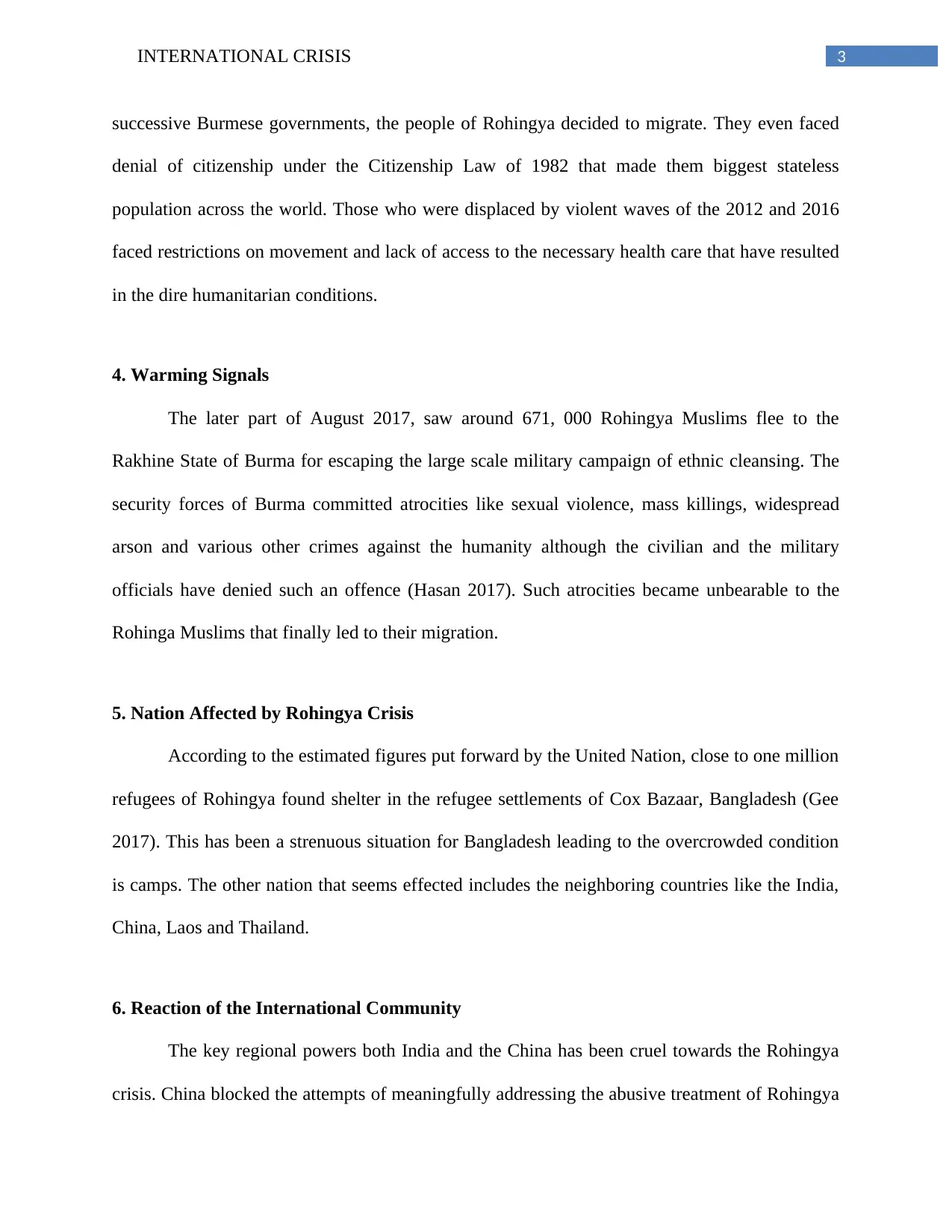
3INTERNATIONAL CRISIS
successive Burmese governments, the people of Rohingya decided to migrate. They even faced
denial of citizenship under the Citizenship Law of 1982 that made them biggest stateless
population across the world. Those who were displaced by violent waves of the 2012 and 2016
faced restrictions on movement and lack of access to the necessary health care that have resulted
in the dire humanitarian conditions.
4. Warming Signals
The later part of August 2017, saw around 671, 000 Rohingya Muslims flee to the
Rakhine State of Burma for escaping the large scale military campaign of ethnic cleansing. The
security forces of Burma committed atrocities like sexual violence, mass killings, widespread
arson and various other crimes against the humanity although the civilian and the military
officials have denied such an offence (Hasan 2017). Such atrocities became unbearable to the
Rohinga Muslims that finally led to their migration.
5. Nation Affected by Rohingya Crisis
According to the estimated figures put forward by the United Nation, close to one million
refugees of Rohingya found shelter in the refugee settlements of Cox Bazaar, Bangladesh (Gee
2017). This has been a strenuous situation for Bangladesh leading to the overcrowded condition
is camps. The other nation that seems effected includes the neighboring countries like the India,
China, Laos and Thailand.
6. Reaction of the International Community
The key regional powers both India and the China has been cruel towards the Rohingya
crisis. China blocked the attempts of meaningfully addressing the abusive treatment of Rohingya
successive Burmese governments, the people of Rohingya decided to migrate. They even faced
denial of citizenship under the Citizenship Law of 1982 that made them biggest stateless
population across the world. Those who were displaced by violent waves of the 2012 and 2016
faced restrictions on movement and lack of access to the necessary health care that have resulted
in the dire humanitarian conditions.
4. Warming Signals
The later part of August 2017, saw around 671, 000 Rohingya Muslims flee to the
Rakhine State of Burma for escaping the large scale military campaign of ethnic cleansing. The
security forces of Burma committed atrocities like sexual violence, mass killings, widespread
arson and various other crimes against the humanity although the civilian and the military
officials have denied such an offence (Hasan 2017). Such atrocities became unbearable to the
Rohinga Muslims that finally led to their migration.
5. Nation Affected by Rohingya Crisis
According to the estimated figures put forward by the United Nation, close to one million
refugees of Rohingya found shelter in the refugee settlements of Cox Bazaar, Bangladesh (Gee
2017). This has been a strenuous situation for Bangladesh leading to the overcrowded condition
is camps. The other nation that seems effected includes the neighboring countries like the India,
China, Laos and Thailand.
6. Reaction of the International Community
The key regional powers both India and the China has been cruel towards the Rohingya
crisis. China blocked the attempts of meaningfully addressing the abusive treatment of Rohingya
Paraphrase This Document
Need a fresh take? Get an instant paraphrase of this document with our AI Paraphraser
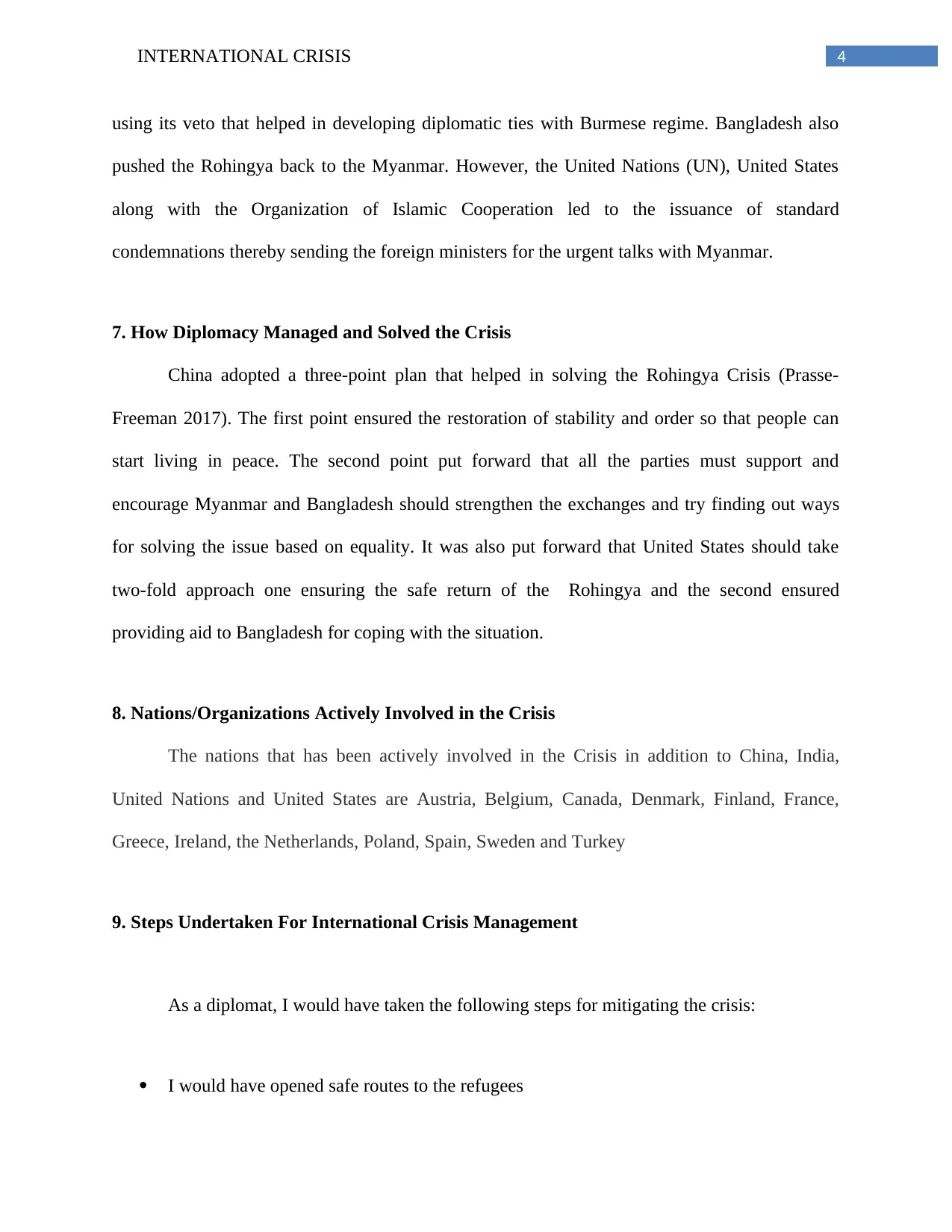
4INTERNATIONAL CRISIS
using its veto that helped in developing diplomatic ties with Burmese regime. Bangladesh also
pushed the Rohingya back to the Myanmar. However, the United Nations (UN), United States
along with the Organization of Islamic Cooperation led to the issuance of standard
condemnations thereby sending the foreign ministers for the urgent talks with Myanmar.
7. How Diplomacy Managed and Solved the Crisis
China adopted a three-point plan that helped in solving the Rohingya Crisis (Prasse‐
Freeman 2017). The first point ensured the restoration of stability and order so that people can
start living in peace. The second point put forward that all the parties must support and
encourage Myanmar and Bangladesh should strengthen the exchanges and try finding out ways
for solving the issue based on equality. It was also put forward that United States should take
two-fold approach one ensuring the safe return of the Rohingya and the second ensured
providing aid to Bangladesh for coping with the situation.
8. Nations/Organizations Actively Involved in the Crisis
The nations that has been actively involved in the Crisis in addition to China, India,
United Nations and United States are Austria, Belgium, Canada, Denmark, Finland, France,
Greece, Ireland, the Netherlands, Poland, Spain, Sweden and Turkey
9. Steps Undertaken For International Crisis Management
As a diplomat, I would have taken the following steps for mitigating the crisis:
I would have opened safe routes to the refugees
using its veto that helped in developing diplomatic ties with Burmese regime. Bangladesh also
pushed the Rohingya back to the Myanmar. However, the United Nations (UN), United States
along with the Organization of Islamic Cooperation led to the issuance of standard
condemnations thereby sending the foreign ministers for the urgent talks with Myanmar.
7. How Diplomacy Managed and Solved the Crisis
China adopted a three-point plan that helped in solving the Rohingya Crisis (Prasse‐
Freeman 2017). The first point ensured the restoration of stability and order so that people can
start living in peace. The second point put forward that all the parties must support and
encourage Myanmar and Bangladesh should strengthen the exchanges and try finding out ways
for solving the issue based on equality. It was also put forward that United States should take
two-fold approach one ensuring the safe return of the Rohingya and the second ensured
providing aid to Bangladesh for coping with the situation.
8. Nations/Organizations Actively Involved in the Crisis
The nations that has been actively involved in the Crisis in addition to China, India,
United Nations and United States are Austria, Belgium, Canada, Denmark, Finland, France,
Greece, Ireland, the Netherlands, Poland, Spain, Sweden and Turkey
9. Steps Undertaken For International Crisis Management
As a diplomat, I would have taken the following steps for mitigating the crisis:
I would have opened safe routes to the refugees
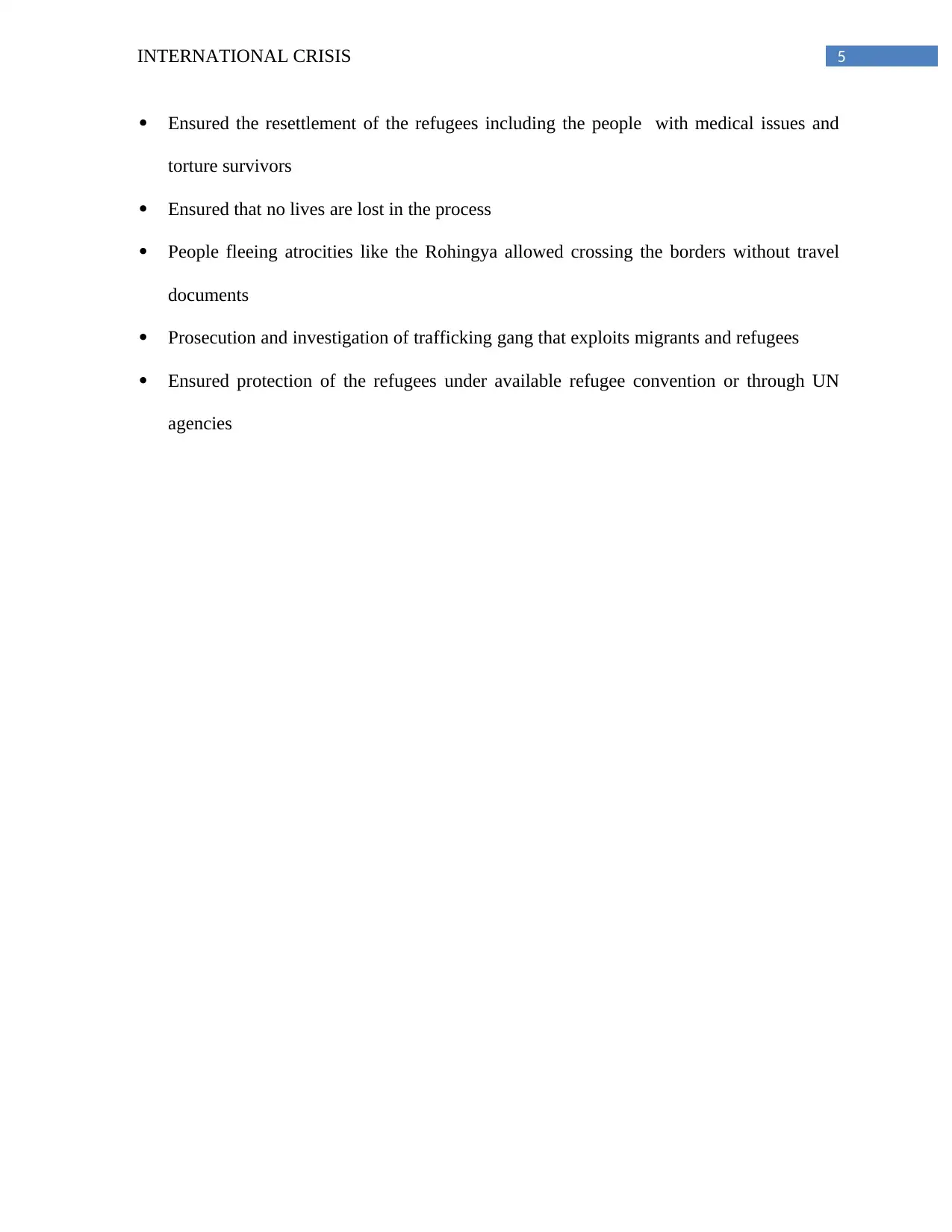
5INTERNATIONAL CRISIS
Ensured the resettlement of the refugees including the people with medical issues and
torture survivors
Ensured that no lives are lost in the process
People fleeing atrocities like the Rohingya allowed crossing the borders without travel
documents
Prosecution and investigation of trafficking gang that exploits migrants and refugees
Ensured protection of the refugees under available refugee convention or through UN
agencies
Ensured the resettlement of the refugees including the people with medical issues and
torture survivors
Ensured that no lives are lost in the process
People fleeing atrocities like the Rohingya allowed crossing the borders without travel
documents
Prosecution and investigation of trafficking gang that exploits migrants and refugees
Ensured protection of the refugees under available refugee convention or through UN
agencies
⊘ This is a preview!⊘
Do you want full access?
Subscribe today to unlock all pages.

Trusted by 1+ million students worldwide
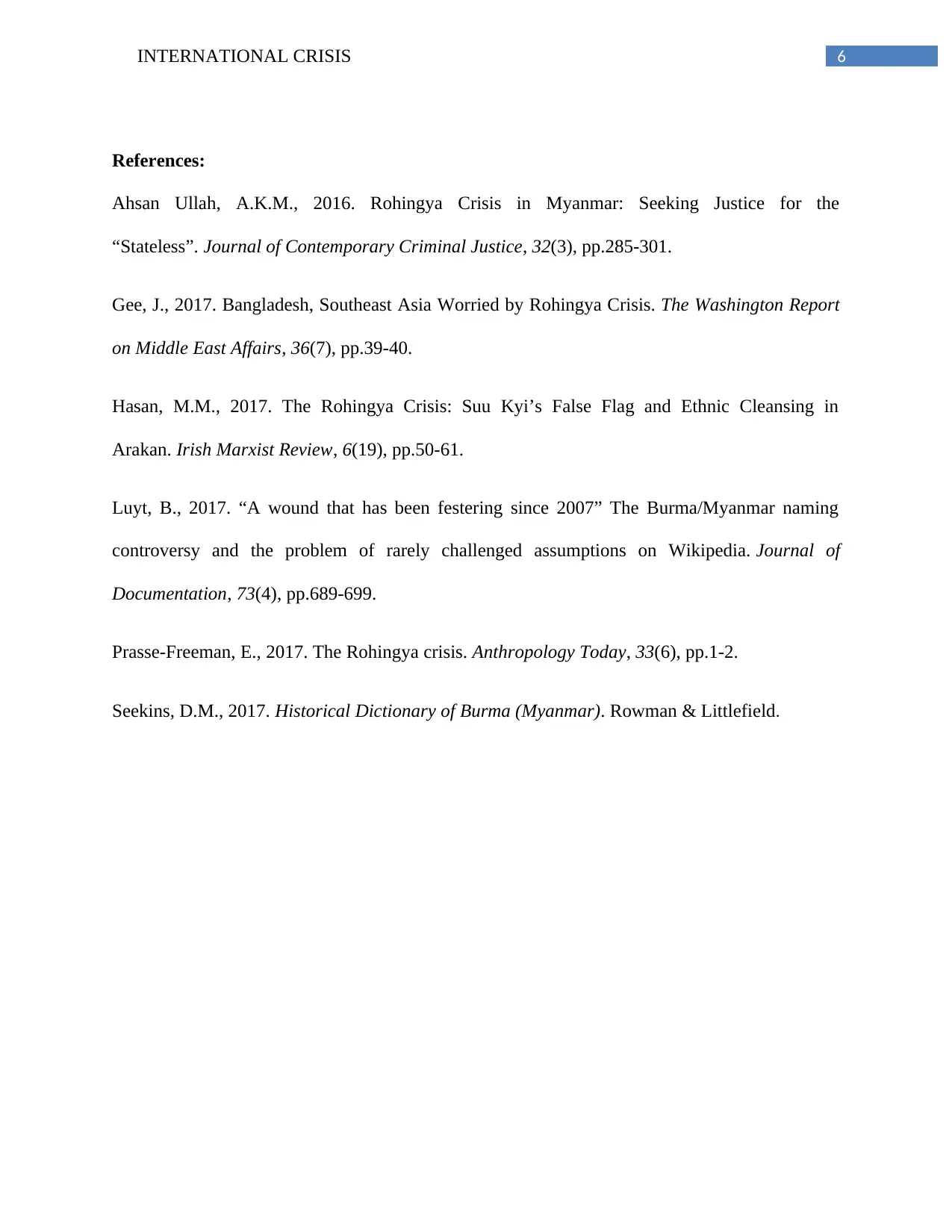
6INTERNATIONAL CRISIS
References:
Ahsan Ullah, A.K.M., 2016. Rohingya Crisis in Myanmar: Seeking Justice for the
“Stateless”. Journal of Contemporary Criminal Justice, 32(3), pp.285-301.
Gee, J., 2017. Bangladesh, Southeast Asia Worried by Rohingya Crisis. The Washington Report
on Middle East Affairs, 36(7), pp.39-40.
Hasan, M.M., 2017. The Rohingya Crisis: Suu Kyi’s False Flag and Ethnic Cleansing in
Arakan. Irish Marxist Review, 6(19), pp.50-61.
Luyt, B., 2017. “A wound that has been festering since 2007” The Burma/Myanmar naming
controversy and the problem of rarely challenged assumptions on Wikipedia. Journal of
Documentation, 73(4), pp.689-699.
Prasse‐Freeman, E., 2017. The Rohingya crisis. Anthropology Today, 33(6), pp.1-2.
Seekins, D.M., 2017. Historical Dictionary of Burma (Myanmar). Rowman & Littlefield.
References:
Ahsan Ullah, A.K.M., 2016. Rohingya Crisis in Myanmar: Seeking Justice for the
“Stateless”. Journal of Contemporary Criminal Justice, 32(3), pp.285-301.
Gee, J., 2017. Bangladesh, Southeast Asia Worried by Rohingya Crisis. The Washington Report
on Middle East Affairs, 36(7), pp.39-40.
Hasan, M.M., 2017. The Rohingya Crisis: Suu Kyi’s False Flag and Ethnic Cleansing in
Arakan. Irish Marxist Review, 6(19), pp.50-61.
Luyt, B., 2017. “A wound that has been festering since 2007” The Burma/Myanmar naming
controversy and the problem of rarely challenged assumptions on Wikipedia. Journal of
Documentation, 73(4), pp.689-699.
Prasse‐Freeman, E., 2017. The Rohingya crisis. Anthropology Today, 33(6), pp.1-2.
Seekins, D.M., 2017. Historical Dictionary of Burma (Myanmar). Rowman & Littlefield.
1 out of 7
Related Documents
Your All-in-One AI-Powered Toolkit for Academic Success.
+13062052269
info@desklib.com
Available 24*7 on WhatsApp / Email
![[object Object]](/_next/static/media/star-bottom.7253800d.svg)
Unlock your academic potential
Copyright © 2020–2025 A2Z Services. All Rights Reserved. Developed and managed by ZUCOL.





